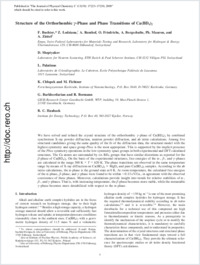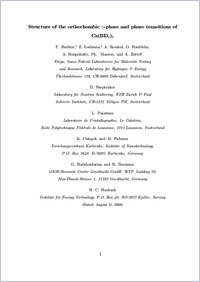Structure of the orthorhombic γ-phase and phase transitions of Ca(BD₄)₂
- Buchter, Florian Empa, Swiss Federal Laboratories for Materials Testing and Research, Laboratory for Hydrogen & Energy, Dübendorf, Switzerland
- Łodziana, Z. Empa, Swiss Federal Laboratories for Materials Testing and Research, Laboratory for Hydrogen & Energy, Dübendorf, Switzerland - Institute of Nuclear Physics, Polish Academy of Sciences, Kraków, Poland
- Remhof, A. Empa, Swiss Federal Laboratories for Materials Testing and Research, Laboratory for Hydrogen & Energy, Dübendorf, Switzerland
- Friedrichs, O. Empa, Swiss Federal Laboratories for Materials Testing and Research, Laboratory for Hydrogen & Energy, Dübendorf, Switzerland
- Borgschulte, A. Empa, Swiss Federal Laboratories for Materials Testing and Research, Laboratory for Hydrogen & Energy, Dübendorf, Switzerland
- Mauron, Philippe Empa, Swiss Federal Laboratories for Materials Testing and Research, Laboratory for Hydrogen & Energy, Dübendorf, Switzerland
- Züttel, Andreas Empa, Swiss Federal Laboratories for Materials Testing and Research, Laboratory for Hydrogen & Energy, Dübendorf, Switzerland - Physics Department, University of Fribourg, Switzerland
- Sheptyakov, D. Laboratory for Neutron Scattering, ETH Zurich & Paul Scherrer Institute, Villigen, Switzerland
- Palatinus, L. Laboratoire de Cristallographie, Le Cubotron, Ecole Polytechnique Fédérale de Lausanne, Switzerland
- Chłopek, K. Forschungszentrum Karlsruhe, Institute of Nanotechnology, Germany
- Fichtner, M. Forschungszentrum Karlsruhe, Institute of Nanotechnology, Germany
- Barkhordarian, G. GKSS-Research Center Geesthacht GmbH, Geesthacht, Germany
- Bormann, R. GKSS-Research Center Geesthacht GmbH, Geesthacht, Germany
- Hauback, B. C. Institute for Energy Technology, Kjeller, Norway
-
09.09.2009
Published in:
- The Journal of Physical Chemistry C. - 2009, vol. 113, no. 39, p. 17223–17230
English
We have solved and refined the crystal structure of the orthorhombic γ-phase of Ca(BD₄)₂ by combined synchrotron X-ray powder diffraction, neutron powder diffraction, and ab initio calculations. Among five structural candidates giving the same quality of the fit of the diffraction data, the structural model with the highest symmetry and space group Pbca is the most appropriate. This is supported by the implicit presence of the Pbca symmetry operations in the low-symmetry space groups in both experimental and DFT calculated structures. The Ca atoms are surrounded by six BD₄ groups that have similar distortions as reported for the β-phase of Ca(BD₄)₂. On the basis of the experimental structures, free energies of the α-, β-, and γ-phases are calculated in the range 300 K < T < 620 K. The phase transitions are observed in the same temperature range by means of X-ray diffraction on Ca(BD₄)₂ + MgD₂ and pure Ca(BD₄)₂ samples. According to the ab initio calculations, the α-phase is the ground state at 0 K. At room temperature, the calculated free energies of the α-phase, β-phase, and γ-phase were found to be within ~0.13 eV/f.u., in agreement with the observed coexistence of these phases. Moreover, calculations provide insight into trends for relative stabilities of α-, β-, and γ-phases. That is, with increasing temperature, the β-phase becomes more stable, while the metastable γ-phase becomes more destabilized with respect to the α-phase.
- Faculty
- Faculté des sciences et de médecine
- Department
- Département de Physique
- Language
-
- English
- Classification
- Chemistry
- License
-
License undefined
- Identifiers
-
- RERO DOC 17035
- DOI 10.1021/jp810521p
- Persistent URL
- https://folia.unifr.ch/unifr/documents/301369
Other files
Statistics
Document views: 114
File downloads:
- pdf: 188
- Supplementary material: 164

